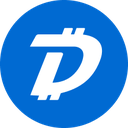-
 Bitcoin
Bitcoin $82,824.9927
0.15% -
 Ethereum
Ethereum $1,812.0443
0.86% -
 Tether USDt
Tether USDt $0.9996
-0.01% -
 XRP
XRP $2.0531
1.26% -
 BNB
BNB $590.8048
0.24% -
 USDC
USDC $0.9999
0.00% -
 Solana
Solana $116.7059
-2.14% -
 Dogecoin
Dogecoin $0.1609
-2.09% -
 Cardano
Cardano $0.6477
0.87% -
 TRON
TRON $0.2377
1.97% -
 Toncoin
Toncoin $3.5900
-6.66% -
 UNUS SED LEO
UNUS SED LEO $9.4427
0.64% -
 Chainlink
Chainlink $12.8223
-0.83% -
 Stellar
Stellar $0.2611
1.72% -
 Avalanche
Avalanche $18.0751
0.35% -
 Sui
Sui $2.2399
-2.19% -
 Shiba Inu
Shiba Inu $0.0...01216
1.00% -
 Hedera
Hedera $0.1620
0.81% -
 Polkadot
Polkadot $4.0442
1.99% -
 Litecoin
Litecoin $83.2343
1.73% -
 MANTRA
MANTRA $6.4018
1.55% -
 Bitcoin Cash
Bitcoin Cash $299.5860
1.69% -
 Bitget Token
Bitget Token $4.4848
0.14% -
 Dai
Dai $1.0000
0.03% -
 Ethena USDe
Ethena USDe $0.9995
-0.03% -
 Monero
Monero $214.4863
0.12% -
 Hyperliquid
Hyperliquid $11.7593
-1.70% -
 Pi
Pi $0.5730
-12.73% -
 Uniswap
Uniswap $5.8248
-0.06% -
 Aptos
Aptos $5.0467
-0.83%
Why is blockchain said to be decentralized?
Blockchain achieves decentralization through distributed ledgers, cryptographic hashing, and consensus mechanisms, enhancing security and resilience but posing scalability challenges.
Mar 28, 2025 at 11:56 am
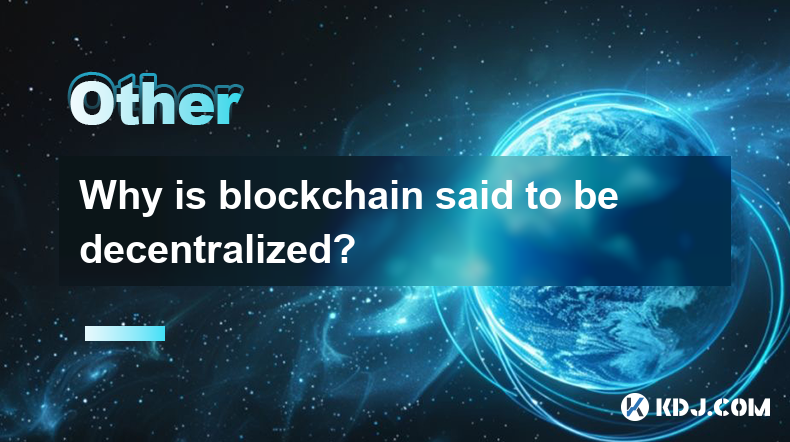
Understanding Decentralization in Blockchain
The term "decentralized" is central to understanding blockchain technology. It contrasts sharply with traditional centralized systems like banks or online databases, which are controlled by a single entity. A decentralized system, like a blockchain, distributes control across a vast network of participants, making it inherently more resistant to single points of failure and censorship. This distribution of power is what makes blockchain truly revolutionary.
How Blockchain Achieves Decentralization
Blockchain achieves decentralization through several key mechanisms. Firstly, it utilizes a distributed ledger. Instead of a single database held by one entity, the blockchain's data is replicated across numerous computers (nodes) in a peer-to-peer network. This means that no single entity has complete control over the data. Any changes to the blockchain require consensus among a significant portion of these nodes.
Secondly, cryptographic hashing secures the blockchain. Each block of transactions is linked to the previous one using cryptographic hashes, creating an immutable chain. This makes altering past transactions incredibly difficult, requiring the manipulation of a significant portion of the network. The cryptographic nature also ensures the integrity and authenticity of the data.
Thirdly, consensus mechanisms are crucial. These are algorithms that determine how nodes agree on the validity of new transactions and add them to the blockchain. Popular examples include Proof-of-Work (PoW) and Proof-of-Stake (PoS). These mechanisms prevent any single entity from dominating the network and adding fraudulent transactions.
Dissecting the Decentralized Nature of Blockchain Networks
The decentralized nature of blockchain isn't absolute. While the goal is complete decentralization, the reality is often nuanced. Some blockchains are more decentralized than others, depending on factors like the distribution of nodes, the mining/staking power, and the governance model.
Network Participants: A truly decentralized blockchain has a large number of geographically dispersed nodes participating in the network. This prevents any single entity or group from controlling a majority of the network's computational power or influence.
Consensus Mechanisms: Different consensus mechanisms have varying levels of decentralization. Proof-of-Work, for instance, can be criticized for its energy consumption and tendency toward centralization due to the dominance of large mining pools. Proof-of-Stake aims to improve decentralization by rewarding participants based on their stake in the network, rather than their computational power.
Governance Models: The governance model determines how decisions about the blockchain's future are made. A decentralized governance model empowers the community, while a centralized one gives control to a select group or entity. This aspect significantly impacts the overall decentralization of the blockchain.
Data Availability: The accessibility of the blockchain data is another crucial factor. A decentralized blockchain should allow anyone to access and verify the data, contributing to transparency and trust.
The Implications of Decentralization in Cryptocurrencies
The decentralized nature of blockchain has profound implications for cryptocurrencies. It contributes to several key features:
- Transparency: All transactions are publicly recorded and verifiable on the blockchain.
- Security: The distributed nature and cryptographic security make it extremely difficult to tamper with the blockchain.
- Resilience: The network is resistant to single points of failure and censorship.
- Trustlessness: Participants don't need to trust each other or a central authority to conduct transactions.
However, decentralization is not without its challenges. It can lead to scalability issues, slower transaction speeds, and complexities in governance. The balance between decentralization, security, and scalability remains a significant area of research and development in the blockchain space.
Exploring Different Levels of Decentralization
It's important to understand that not all blockchains are equally decentralized. Some projects prioritize scalability over decentralization, leading to a more centralized architecture. Others strive for maximal decentralization, even if it means compromising on some performance aspects.
- Highly Decentralized: These blockchains have a vast number of nodes, diverse geographical distribution, and robust consensus mechanisms that resist centralization.
- Moderately Decentralized: These blockchains may have a smaller number of nodes or rely on consensus mechanisms that are more susceptible to influence from larger stakeholders.
- Centralized (or Semi-Centralized): These systems might have a smaller number of controlling nodes, giving a smaller group more power. While they may utilize blockchain technology, they don't embody the core principles of decentralization.
Understanding the degree of decentralization in a specific blockchain is vital for assessing its security, resilience, and overall suitability for various applications. This requires careful examination of its technical architecture, governance model, and community participation.
Frequently Asked Questions
Q: Is a completely decentralized blockchain possible?
A: While the ideal is complete decentralization, achieving it perfectly is challenging. Factors like network effects, technological limitations, and economic incentives can influence the level of decentralization.
Q: What are the benefits of a decentralized blockchain?
A: The key benefits include enhanced security, resilience to censorship and single points of failure, increased transparency, and trustlessness.
Q: What are the drawbacks of a decentralized blockchain?
A: Drawbacks can include scalability challenges, slower transaction speeds, and complexities in governance.
Q: How can I assess the level of decentralization of a blockchain?
A: Examine the number and distribution of nodes, the consensus mechanism used, the governance model, and the overall community involvement. Research the project's whitepaper and its active community participation.
Q: What is the difference between centralized and decentralized systems?
A: Centralized systems have a single point of control, while decentralized systems distribute control across multiple participants, making them more resilient and less susceptible to censorship.
Disclaimer:info@kdj.com
The information provided is not trading advice. kdj.com does not assume any responsibility for any investments made based on the information provided in this article. Cryptocurrencies are highly volatile and it is highly recommended that you invest with caution after thorough research!
If you believe that the content used on this website infringes your copyright, please contact us immediately (info@kdj.com) and we will delete it promptly.
- As SHIB and PEPE Holders Seek Stability, RCO Finance Emerges as a Hedge
- 2025-04-04 07:35:11
- Cango Sells Its China Operations for $351.94 Million, Pivoting Towards Cryptocurrency Mining
- 2025-04-04 07:35:11
- Cango Inc. Pivots to Bitcoin Mining, Exiting the Chinese Auto-Financing Market
- 2025-04-04 07:30:11
- Crypto analyst CasiTrades has provided a roadmap for the XRP price
- 2025-04-04 07:30:11
- In the world of AI and blockchain, where buzzwords often outpace actual innovation, Intellex stands apart
- 2025-04-04 07:25:13
- Stablecoins shifted their weight in Q1, flowing into a new set of chains
- 2025-04-04 07:25:13
Related knowledge
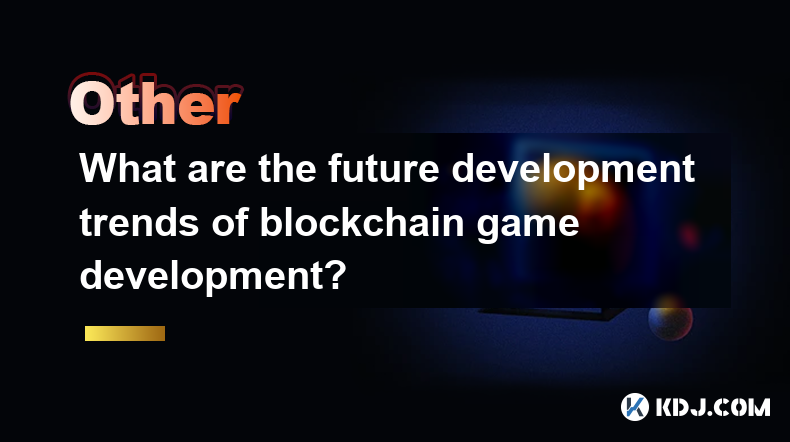
What are the future development trends of blockchain game development?
Apr 03,2025 at 05:00am
Blockchain technology has revolutionized various industries, and gaming is no exception. As we look to the future, several trends are set to shape the development of blockchain games. These trends not only promise to enhance the gaming experience but also to integrate blockchain technology more seamlessly into the gaming ecosystem. Let's explore these t...
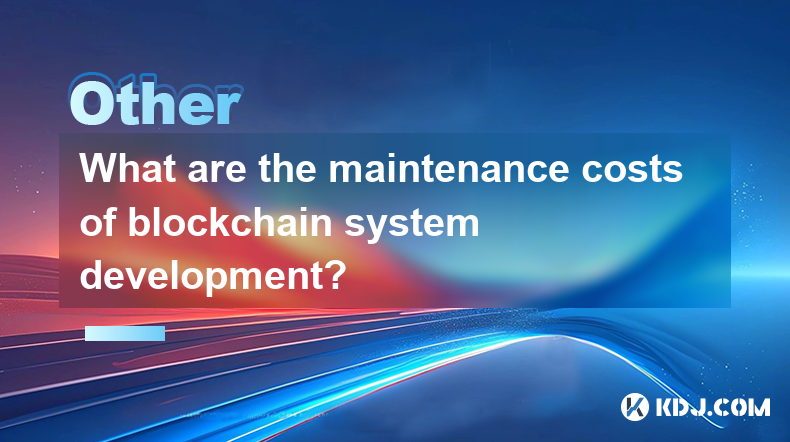
What are the maintenance costs of blockchain system development?
Apr 03,2025 at 06:07pm
The maintenance costs of blockchain system development are multifaceted and depend on various factors. These costs can include technical maintenance, security updates, infrastructure expenses, and personnel costs. Understanding these elements is crucial for anyone planning to develop or maintain a blockchain system. Technical MaintenanceTechnical mainte...
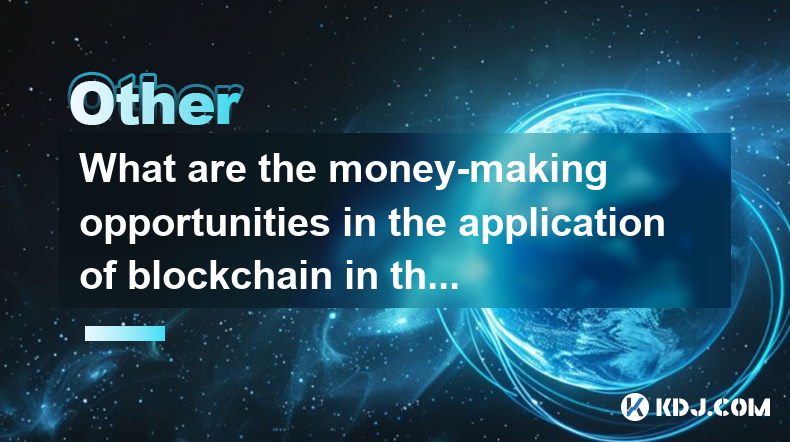
What are the money-making opportunities in the application of blockchain in the medical industry?
Apr 03,2025 at 03:35am
The integration of blockchain technology into the medical industry presents a myriad of money-making opportunities that can revolutionize healthcare systems. Blockchain's inherent characteristics, such as transparency, security, and immutability, make it an ideal solution for various medical applications. By leveraging blockchain, companies can develop ...
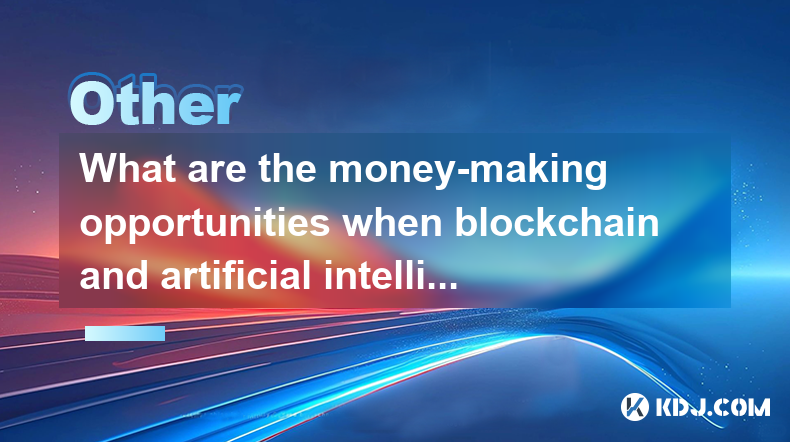
What are the money-making opportunities when blockchain and artificial intelligence are combined?
Apr 04,2025 at 01:28am
The convergence of blockchain and artificial intelligence (AI) presents a myriad of money-making opportunities within the cryptocurrency circle. This fusion leverages the decentralized and secure nature of blockchain with the analytical prowess of AI, creating innovative solutions and platforms that can generate significant revenue. From enhancing tradi...
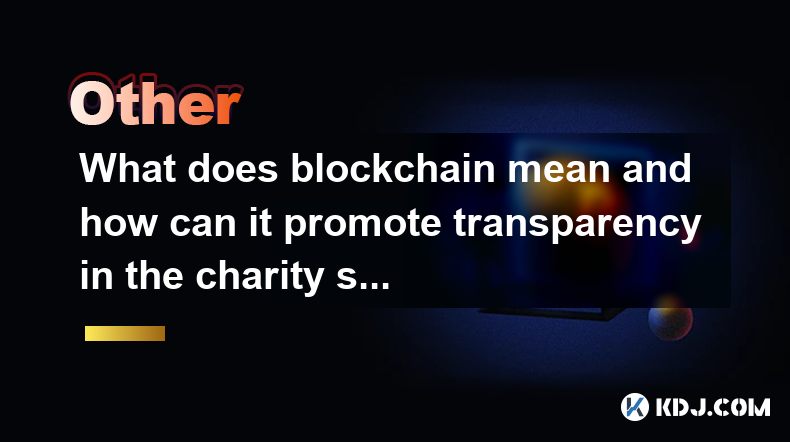
What does blockchain mean and how can it promote transparency in the charity sector?
Apr 03,2025 at 08:29pm
Blockchain technology is a decentralized, distributed ledger that records transactions across numerous computers. This ensures that the data is transparent and nearly impossible to alter retroactively. Essentially, blockchain serves as a digital ledger of all cryptocurrency transactions, enabling secure and direct exchanges without the need for intermed...
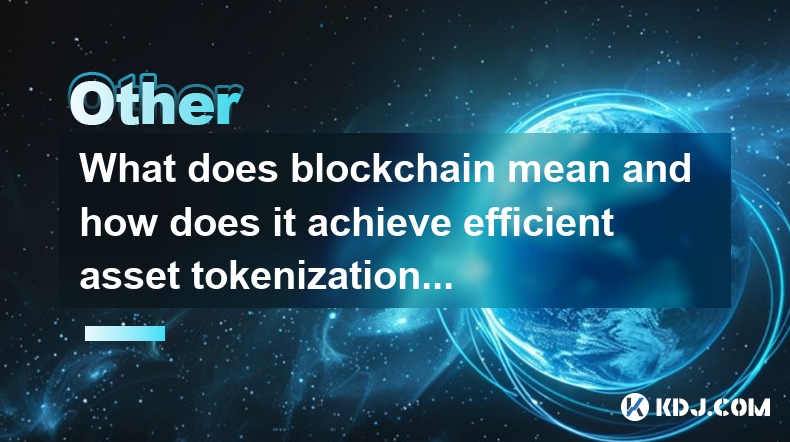
What does blockchain mean and how does it achieve efficient asset tokenization?
Apr 03,2025 at 07:57pm
Blockchain technology is a decentralized, distributed ledger that records transactions across numerous computers. It ensures that each transaction is secure, transparent, and immutable. The concept of blockchain was introduced with the launch of Bitcoin in 2009, but its applications have since expanded far beyond cryptocurrencies. At its core, blockchai...

What are the future development trends of blockchain game development?
Apr 03,2025 at 05:00am
Blockchain technology has revolutionized various industries, and gaming is no exception. As we look to the future, several trends are set to shape the development of blockchain games. These trends not only promise to enhance the gaming experience but also to integrate blockchain technology more seamlessly into the gaming ecosystem. Let's explore these t...

What are the maintenance costs of blockchain system development?
Apr 03,2025 at 06:07pm
The maintenance costs of blockchain system development are multifaceted and depend on various factors. These costs can include technical maintenance, security updates, infrastructure expenses, and personnel costs. Understanding these elements is crucial for anyone planning to develop or maintain a blockchain system. Technical MaintenanceTechnical mainte...

What are the money-making opportunities in the application of blockchain in the medical industry?
Apr 03,2025 at 03:35am
The integration of blockchain technology into the medical industry presents a myriad of money-making opportunities that can revolutionize healthcare systems. Blockchain's inherent characteristics, such as transparency, security, and immutability, make it an ideal solution for various medical applications. By leveraging blockchain, companies can develop ...

What are the money-making opportunities when blockchain and artificial intelligence are combined?
Apr 04,2025 at 01:28am
The convergence of blockchain and artificial intelligence (AI) presents a myriad of money-making opportunities within the cryptocurrency circle. This fusion leverages the decentralized and secure nature of blockchain with the analytical prowess of AI, creating innovative solutions and platforms that can generate significant revenue. From enhancing tradi...

What does blockchain mean and how can it promote transparency in the charity sector?
Apr 03,2025 at 08:29pm
Blockchain technology is a decentralized, distributed ledger that records transactions across numerous computers. This ensures that the data is transparent and nearly impossible to alter retroactively. Essentially, blockchain serves as a digital ledger of all cryptocurrency transactions, enabling secure and direct exchanges without the need for intermed...

What does blockchain mean and how does it achieve efficient asset tokenization?
Apr 03,2025 at 07:57pm
Blockchain technology is a decentralized, distributed ledger that records transactions across numerous computers. It ensures that each transaction is secure, transparent, and immutable. The concept of blockchain was introduced with the launch of Bitcoin in 2009, but its applications have since expanded far beyond cryptocurrencies. At its core, blockchai...
See all articles


















































































